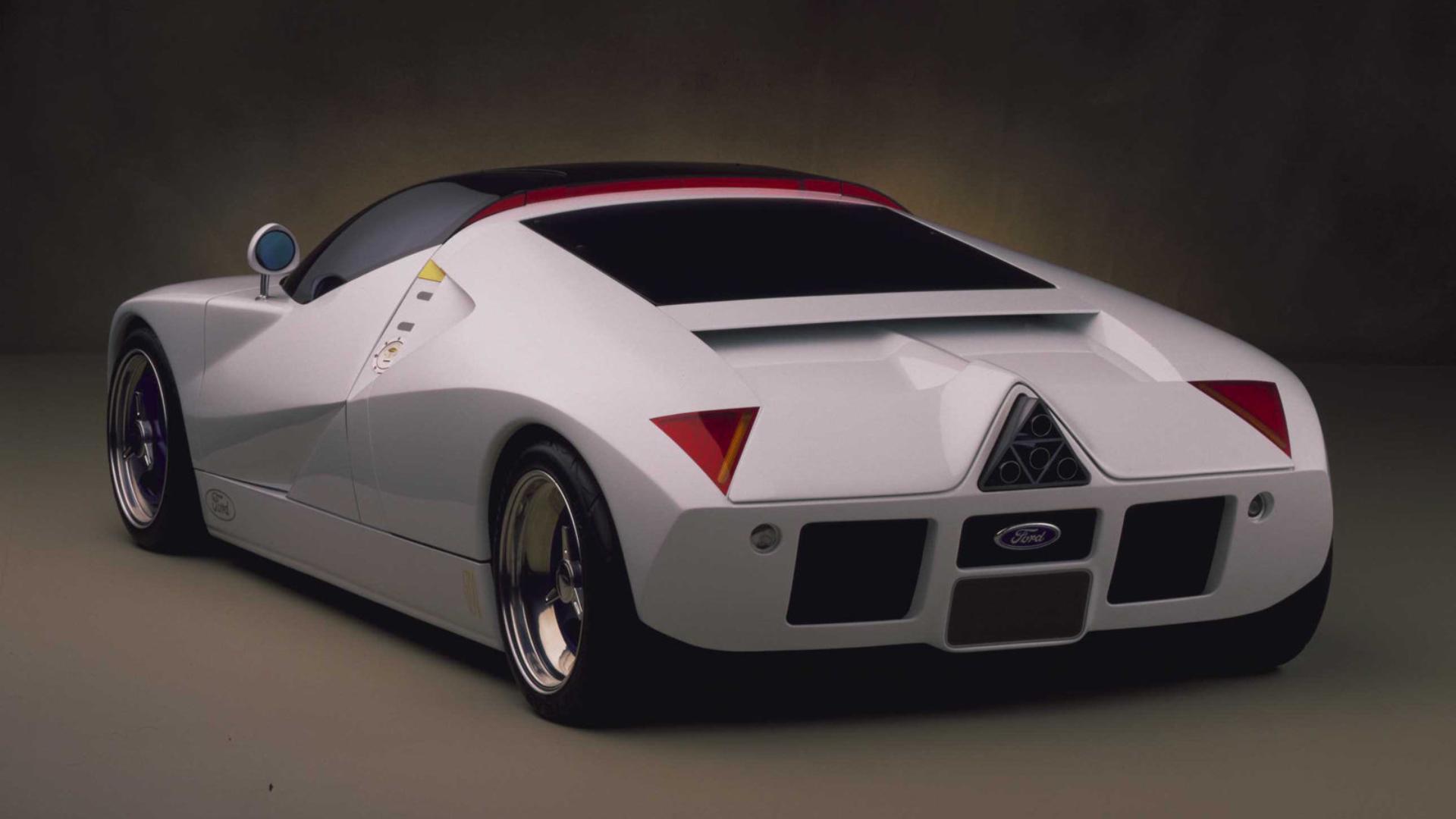Some cars have achieved legendary status for various reasons, such as rarity, performance, or that absolute “wow factor.” One standout from the mid-1990s supercar scene, the Ford GT90, embodies all these qualities. Since its memorable appearance on Top Gear in 1995, the car has become a major curiosity in automotive history. Unfortunately, it vanished from the scene, remaining one of the most interesting cars that never quite basked in the limelight, like the Ford GT supercar.
Even today, the GT90 retains a certain sporty character when compared to contemporary cars. Notably, its rear spoiler springs into action at around 160 MPH, adding a dynamic touch to its performance. Moreover, the exhaust’s heat shield is crafted from the same material employed in space shuttles. The careful selection of materials underscores the GT90’s dedication to balancing form and function, as it acknowledges the potential harm that the exhaust’s heat could inflict on the car’s body. Keeping all this in mind, here’s what happened to the Ford GT90 supercar.

Ford GT90 Overview
Back in 1990, during the Detroit motor show, a biting chill hung in the air with icy roads and snow lining the sidewalks. In the early hours, as press and exhibitors eagerly waited for the doors of Cobo Hall to swing open, huddled figures could be spotted, braving the cold with chins tucked into scarves.
This marked the onset of America’s grandest auto show, where the giants of the car industry would showcase their might. Executives would deliver confident speeches while designers and engineers paraded alongside their latest creations, ready to present a meticulously rehearsed PR pitch, asserting why their newest car would revolutionize the market and captivate consumers.
And then enters the Ford GT90 into the supercar scene. The car needed no introduction or any PR.
This world-conquering supercar, with its quad-turbo V-12 engine capable of reaching 235 mph, caused a stir. Reporters scrambled to cover it, and editors hastily reshaped front pages to feature Ford’s sensational creation. Not since the 1964 unveiling of the GT40, in the midst of Ford’s battle with Ferrari, had the company experienced such a reaction. Once again, car enthusiasts couldn’t get enough. So, what prevented Ford from bringing the breathtaking GT90 to life?
What Made The Ford GT90 So Special?

The GT90 concept is a mid-engine supercar built on a modified Jaguar XJ220 chassis. In 1995, Ford unveiled the GT90 at the North American International Auto Show in Detroit, leaving a lasting impression on everyone, starting from video games to teenagers. The futuristic, geometric design, coupled with a hidden quad-turbo V-12 beneath its sleek fighter-jet profile and astonishing performance metrics such as a 3.1-second 0-to-60-mph time and a top speed of 235 mph, rendered it a piece of automotive fantasy.
However, the dream was just that—pure fantasy—since Ford never seriously contemplated mass production. The solitary show car, created at an estimated cost of $3 million, remains the only one in existence.
Despite the absence of production plans, the GT90 managed to capture attention on various fronts. Motor Trend conducted a test drive, and Jeremy Clarkson expressed sheer enthusiasm for it on Top Gear (though he later deemed it “horrid” and likened its handling to a cartoon in a subsequent episode).
Existing mainly in video games such as Need for Speed II SE, Ford Racing 3, and Gran Turismo 2, the GT90 attained digital icon status. I vividly recall a sense of disappointment in the latter game, excited to finally virtually experience my dream car, only to find that Jeremy Clarkson’s review remained true even in the games. Consequently, his reviews matter, and so does Jeremy Clarkson’s choice of favorite cars.
The Ford GT90 Was Chopped From a Jaguar XJ220

Scott reminisces, “I wanted to embark on something that exuded a grounded aesthetic, showcasing a novel approach to car surfacing, breaking away from the perpetual roundness. I tasked six designers with the challenge, and it was Jim Hope who sketched a vision reminiscent of a futuristic GT40. To bring it to life, we needed a functional chassis.
Hearing that Jaguar, then under Ford ownership, was facing challenges in selling its XJ220 supercar, we arranged for one to be sent over. We then proceeded to strip away the bodywork, extend the chassis, and install an experimental V-12!”
The genesis of the engine traces back to Ford’s Advanced Powertrain department, initially conceived as a theoretical exercise grounded in the new-for-the-nineties Modular Engine. This engine variant is available as a 4.6-liter V-8 in vehicles ranging from the Mustang to the Prodrive-developed Rover 75, which is a story itself, and as a 6.8-liter V-10 in Ford’s full-size E-Series vans and F-Series pickups.
A 5.9-liter V12 Modular Engine Powered the Ford GT

Engine designer Bob Natkin took a creative approach by beam-welding one half of the new V-8 to a V-8 block, successfully breathing life into the makeshift V-12, which found itself powering a Lincoln Town Car. This unusual pairing might have remained confined to the realms of experimentation if it weren’t for John Coletti, the driving force behind the perpetuity of the Mustang.
At the helm of SVT (Special Vehicle Team), the specialized group responsible for crafting Ford’s high-performance U.S. models and the British SVE (Special Vehicle Engineering) group, Coletti caught wind of this unconventional creation. Distinct from their counterparts in Essex, the U.S.-based SVT team not only engineered vehicles but also took charge of selling and marketing them. While a decade earlier, they had attempted to birth the GN34 supercar to challenge Ferrari, this time, Coletti set a more modest goal: creating a unique runner with no production aspirations.
Fred Goodnow, SVT’s Engineering Manager, received the directive to amalgamate the Jaguar chassis with Jim Hope’s cutting-edge bodywork. They also harnessed the power of a quad-turbocharged version of Natkin’s 350ci 5.9-liter V-12, boasting an impressive 720 hp—enough to outpace the McLaren F1, which had recently set the world speed record for a production car.
Ford claimed that the GT90 has a top speed of 253 miles per hour, which is enough to make it up to the fastest cars in the world even today. While Ford has built numerous reliable engines that could go over 500,000 miles, the Ford GT90’s engine went untested.
Ford GT90 Was Named After Le Man’s Winner – GT70

Naming Ford’s new supercar proved to be a straightforward task. Following the tradition of the GT40, which took its name from Le Mans winners, and the subsequent, albeit stillborn, GT70, the continuation of the GT-letter legacy seemed natural. Even though the four drivable roadgoing GT70s had been created years earlier, lacking the race-winning chassis of their namesake, the GT-letter dynasty persisted. Thus, the latest addition to the line was christened GT90, accompanied by tires featuring hand-cut GT90 lettering as distinctive treads.
Scott reflects on the initial reception, noting that the striking machine faced skepticism from Ford’s senior management and the Detroit press. However, perceptions shifted when the broader public and international press got a glimpse. The mesmerizing display of triangles captured attention, although Scott had hoped that people would focus more on the taut surfaces that crafted the sharp edges rather than the outline shapes themselves.
As curiosity grew, inquiries regarding this new style reached Ford’s Global Vice President of Design, Jack Telnack. People wanted to know if it represented the future. Jack’s response resonated: future Fords would embrace what he termed “New Age Edge.” Eventually, he streamlined it to simply “New Edge.”
What Happened To The Rare Ford GT90?

The GT90 created such a buzz that Ford’s senior management, spurred on by Coletti’s encouragement, began exploring avenues to transform the car from a mere statement of intent. Fred Goodnow, the project manager for the GT90, went as far as telling Jeremy Clarkson that with a two to three-year development program, they could undoubtedly create a car that was not only fully competitive but even “better” than contemporaries from McLaren, Bugatti, and Ferrari.
However, challenges emerged at this juncture.
Despite the design success, Scott’s creation was more about fostering new design thinking than serving as a flagship car for Ford. It was a one-off, conceived and engineered without contemplating the transition from a two-seat, quad-turbo V-12, 720 hp supercar into a production reality.
Ideas were tossed around, including the possibility of dismantling more Jaguar XJ220s, but the economics did not align. Bob Natkin had developed another V-12 based on Ford’s V-6 Duratec engine, intended for Aston Martin. However, it presented a political hurdle rather than a practical solution. Using that engine would place the blue oval brand in the realm of exotic-engined, six-figure supercars, a territory reserved for the Ford-owned Aston Martin brand. Approving such a plan would essentially pit Ford against itself.
Consequently, the sensational GT90 remained a solitary masterpiece. It had fulfilled its purpose, rekindling the creative spirits of a demoralized design team and leaving a lasting influence on acclaimed cars like the Ka, Puma, Focus, and even the Cougar. However, those anticipating Ford’s return to challenging Ferrari were left disappointed. Aston Martin took up that mantle.
Yet, the enthusiasm surrounding the GT90 was not extinguished entirely. Its challenger spirit breathed new life into the decision-makers at Ford. Recognizing the need for a flagship supercar, the company looked to its past for inspiration.
Camilo Pardo, the mind behind some of the edgy design sketches at Ghia, was working for Ford in the early 2000s when the trend of retromodern design was at its peak, featuring BMW’s Z8 and the Mini. Although New Edge had fallen out of fashion by then, the spirit of the GT90 persisted. John Coletti was entrusted with engineering a mid-engined GT, and Pardo was tasked with infusing it with retro looks.
The result, the new GT40 Concept unveiled in 2002, appeared as more than just an update of the old road-going racer. Without the one-off GT90 in between, Ford might have lost the desire for a life-affirming supercar and potentially terminated its supercar legacy altogether.

